

The Yolngu. WARNING: Visitors should be aware that this website includes images and names of deceased people that may cause sadness or distress to Aboriginal and Torres Strait Islander peoples.
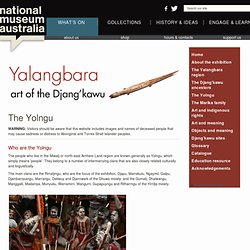
Who are the Yolngu The people who live in the Miwatj or north-east Arnhem Land region are known generally as Yolngu, which simply means 'people'. They belong to a number of intermarrying clans that are also closely related culturally and linguistically. The main clans are the Rirratjingu, who are the focus of the exhibition, Djapu, Marrakulu, Ngaymil, Galpu, Djambarrpuingu, Marrangu, Datiwuy and Djarrrwark of the Dhuwa moiety: and the Gumatj, Dhalwangu, Manggalli, Madarrpa, Munyuku, Warramirri, Wangurri, Gupapuyngu and Ritharrngu of the Yirritja moiety. Macassan History in Arnhem Land - ABC Darwin. If you listen to the Yolngu language of East Arnhem Land closely, you'll come across a few familiar sounding words, for example 'Rupiah', the Indonesian word for money.
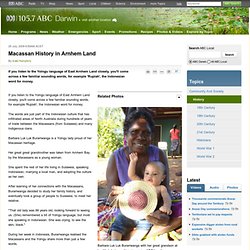
The words are just part of the Indonesian culture that has infiltrated areas of North Australia during hundreds of years of trade between the Macassans (from Sulawesi) and many Indigenous clans. Barbara Luk Luk Burarrwanga is a Yolngu lady proud of her Macassan heritage. Her great great grandmother was taken from Arnhem Bay by the Macassans as a young woman. She spent the rest of her life living in Sulawesi, speaking Indonesian, marrying a local man, and adopting the culture as her own. After learning of her connections with the Macassans, Burarrwanga decided to study her family history, and eventually took a group of people to Sulawesi, to meet her relative. "That old lady was 99 years old, looking forward to seeing us. A blue, white and yellow flag is flown proudly in East Arnhem Land. "They didn't shoot. '1. Understanding the Macassans: A regional approach' in Macassan History and Heritage by Edited by Marshall Clark...
1.
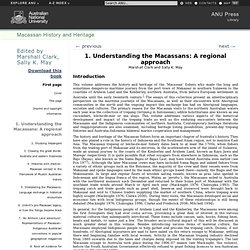
Understanding the Macassans: A regional approach Marshall Clark and Sally K. May Introduction This volume addresses the history and heritage of the ‘Macassan’ fishers who made the long and sometimes dangerous maritime journey from the port town of Makassar in southern Sulawesi to the coastline of Arnhem Land and the Kimberley, northern Australia, from before European settlement in Australia until the early twentieth century. Aasj04.1_%20makassan. Chinese Discoverers. Were The Chinese The First To Discover Australia By Rex Gilroy Australasian Post, May 1, 1986 Chinese Discoverers Aboriginal paintings depict Chinese junks...Ancient Chinese writings describing apparent Kangaroo's.
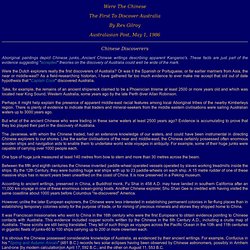
Accepted " theories on the discovery of Australia could well be wide of the mark. Were the Dutch explorers really the first discoverers of Australia? Captain Cook " discovered Australia. Take, for example, the remains of an ancient shipwreck claimed to be a Phoenician trireme at least 2500 or more years old and which was located near King Sound, Western Australia, some years ago by the late Perth diver Allan Robinson. Perhaps it might help explain the presence of apparent middle-east racial features among local Aboriginal tribes of the nearby Kimberleys region. But what of the ancient Chinese who were trading in these same waters at least 2500 years ago? One type of huge junk measured at least 140 metres from bow to stern and more than 30 metres across the beam. Spring and Autumn Annals. Australian History Timeline.
Overview of European exploration Southern Hemisphere 1567-1772. Download a PDF version of this page Alvaro do Mendana reached the Solomon Islands.
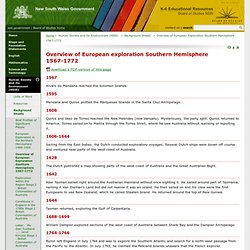
Mendana and Quiros plotted the Marquesas Islands in the Santa Cruz Archipelago. Quiros and Vaez de Torres reached the New Hebrides (now Vanuatu). Mysteriously, the party split. Quiros returned to America; Torres sailed on to Manila through the Torres Strait, where he saw Australia without realising or reporting it. Sailing from the East Indies, the Dutch conducted exploratory voyages. The Dutch published a map showing parts of the west coast of Australia and the Great Australian Bight. Abel Tasman sailed right around the Australian mainland without once sighting it. Tasman returned, exploring the Gulf of Carpentaria. William Dampier explored sections of the west coast of Australia between Shark Bay and the Dampier Archipelago. Byron left England in July 1764 and was to explore the Southern Atlantic and search for a north-west passage from the Pacific to the Atlantic.